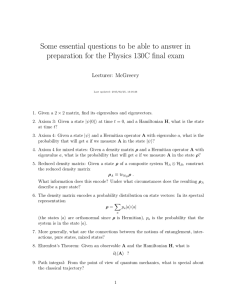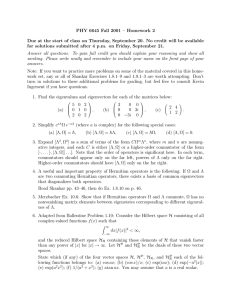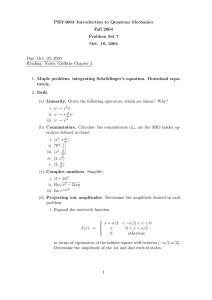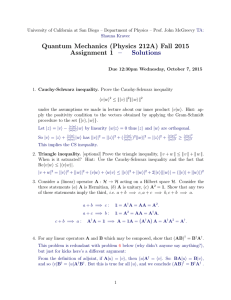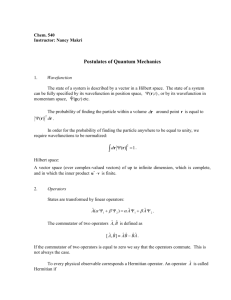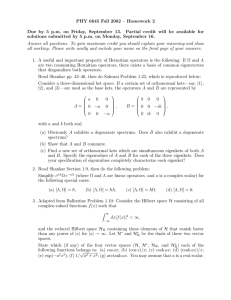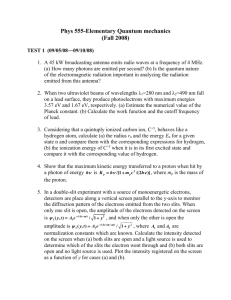Quantum Mechanics (Physics 212A) Fall 2015 Assignment 1 – Solutions
advertisement
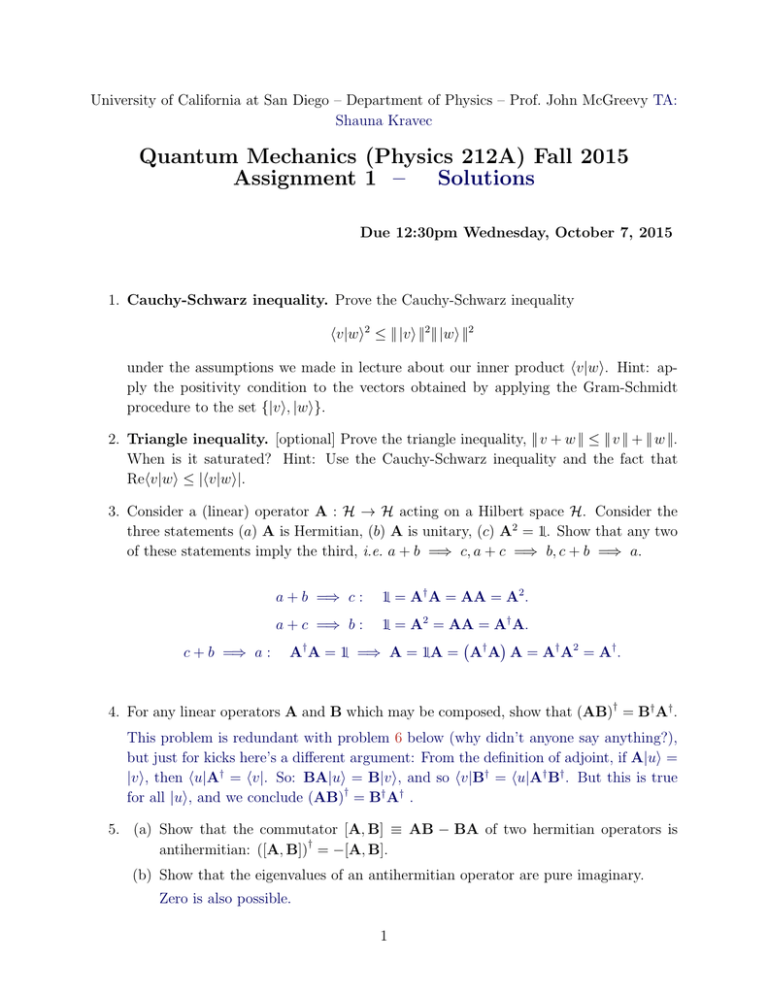
University of California at San Diego – Department of Physics – Prof. John McGreevy TA:
Shauna Kravec
Quantum Mechanics (Physics 212A) Fall 2015
Assignment 1 –
Solutions
Due 12:30pm Wednesday, October 7, 2015
1. Cauchy-Schwarz inequality. Prove the Cauchy-Schwarz inequality
hv|wi2 ≤ || |vi ||2 || |wi ||2
under the assumptions we made in lecture about our inner product hv|wi. Hint: apply the positivity condition to the vectors obtained by applying the Gram-Schmidt
procedure to the set {|vi, |wi}.
2. Triangle inequality. [optional] Prove the triangle inequality, || v + w || ≤ || v || + || w ||.
When is it saturated? Hint: Use the Cauchy-Schwarz inequality and the fact that
Rehv|wi ≤ |hv|wi|.
3. Consider a (linear) operator A : H → H acting on a Hilbert space H. Consider the
three statements (a) A is Hermitian, (b) A is unitary, (c) A2 = 1. Show that any two
of these statements imply the third, i.e. a + b =⇒ c, a + c =⇒ b, c + b =⇒ a.
a + b =⇒ c :
1 = A† A = AA = A2 .
1 = A2 = AA = A† A.
A† A = 1 =⇒ A = 1A = A† A A = A† A2 = A† .
a + c =⇒ b :
c + b =⇒ a :
4. For any linear operators A and B which may be composed, show that (AB)† = B† A† .
This problem is redundant with problem 6 below (why didn’t anyone say anything?),
but just for kicks here’s a different argument: From the definition of adjoint, if A|ui =
|vi, then hu|A† = hv|. So: BA|ui = B|vi, and so hv|B† = hu|A† B† . But this is true
for all |ui, and we conclude (AB)† = B† A† .
5. (a) Show that the commutator [A, B] ≡ AB − BA of two hermitian operators is
antihermitian: ([A, B])† = −[A, B].
(b) Show that the eigenvalues of an antihermitian operator are pure imaginary.
Zero is also possible.
1
6. Show that for any two linear maps which may be composed, T : V1 → V2 , S : V2 → V3 ,
(ST)† = T† S† .
Let {|ii}, {|ni}, {|ai} denote bases for V1,2,3 respectively. Then
?
hi| (ST)† |ai = (ha|ST|ii)
X
=
(ha|S|nihn|T|ii)?
n
X
=
hn|S† |aihi|T† |ni
n
X
=
hi|T† |nihn|S† |ai
n
= hi|T† S† |ai.
(1)
7. For A and B hermitian operators, show that AB is hermitian if and only if A and B
commute.
From either 6 or 4, we know that in general,
(AB)† = B† A†
but for hermitian operators, the RHS is BA which is equal to the LHS only when
0 = AB − BA = [A, B].
8. Consider three normal operators A, B, C satisfying
[A, B] = 0, [A, C] = 0 but [B, C] 6= 0.
(a) Show that there must be a degeneracy in the spectrum of A.
(b) The nature of the degeneracy depends on the form of [B, C]. Suppose that [B, C]
is a nonzero c-number. Show that under this assumption the degeneracy of each
eigenvalue of A cannot be finite.
Let Va be the eigenspace of A with some eigenvalue a. On Va ,
trVa [B, C] = trVa q1 = qdim(Va )
On the other hand,
trVa [B, C] = trVa BC − trVa CB = 0
by cyclicity of the trace.
2
9. Supersymmetry algebra. Consider an operator Q satisfying Q2 = 0.
Let A ≡ QQ† + Q† Q.
Show that any nonzero eigenvalue of A is degenerate (that is, there is more than one
eigenvector with the same eigenvalue), but zero eigenvalues need not be.
Hint: consider the action of Q + Q† on an eigenstate of A.
A good example to keep in mind in doing this problem is a two state system with
01
+
x
y
Q ≡ σ ≡ σ + iσ =
, A = 1.
00
2
First notice that A = Q + Q† . Second notice that
AQ = QQ† Q = QA
i.e. [A, Q] = 0, A and Q commute. Similarly, A and Q† commute. Q and Q† are not
hermitian – in fact, since they square to zero, all their eigenvalues must be zero (act
with Q on the eigenvalue equation for Q). But Q + Q† and i Q − Q† are hermitian
and simultaneously diagonalizable with A. Now suppose we have an A eigenstate:
A|αi = α|αi.
Consider the state Q|αi. Since [A, Q] = 0, it is also an A eigenstate with eigenvalue
α. Is it proportional to |αi, i.e. the same state? (If not, we have shown a degeracy.)
If it were,
Q|αi = q|αi
then it would be an eigenvector of Q with eigenvalue q. But we know that any eigenvalue of Q is zero. So the only case where there is not a degeneracy is when
Q|αi = 0 .
10. Normal matrices.
An operator (or matrix)  is normal if it satisfies the condition [Â, † ] = 0.
(a) Show that real symmetric, hermitian, real orthogonal and unitary operators are
normal.
(b) Show that any operator can be written as  = Ĥ + iĜ where Ĥ, Ĝ are Hermitian.
[Hint: consider the combinations  + † ,  − † .] Show that  is normal if and
only if [Ĥ, Ĝ] = 0.
3
(c) Show that a normal operator  admits a spectral representation
 =
N
X
λi P̂i
i=1
for a set of projectors P̂i , and complex numbers λi .
11. The space of linear operators on H is also a Hilbert space.
(a) Show that with the inner product
(S, T ) ≡ tr(S † T )
(the Hilbert-Schmidt inner product) the space of linear operators on a Hilbert
space H is itself a Hilbert space.
(b) What is its dimension? (Hint: make an orthonormal basis for it using an ON
basis for H.)
P
Let H = span{|ji, j = 1..N }, and assume this basis is ON so that 1 = j |jihj|.
Then any linear operator on H can be written
A = 1A1 =
N
X
|jihj|A|kihk| =
j,k=1
X
Ajk |jihk|.
jk
This says that the operators
E(jk) ≡ |jihk|
span the vector space of operators on H. What are their inner products?
X
(E(jk), E(lm)) = trE(jk)† E(lm) =
hi| (|kihj|) (|lihm|) |ii = δkm δlj .
i
In particular, the norm is
|| E(jk) ||2 = (E(jk), E(jk)) = 1.
They are orthonormal. The dimension of the space of operators is therefore
(dim H)2 .
(c) Show that the Pauli matrices and the identity (appropriately normalized) are
orthonormal with respect to the Hilbert-Schmidt inner product. Do they provide
a basis for the space of operators acting on a two-state system?
4
